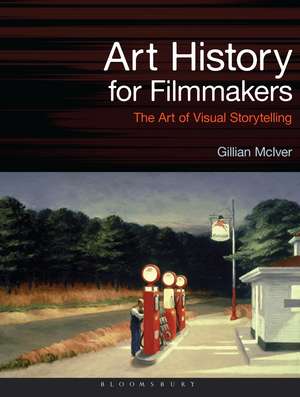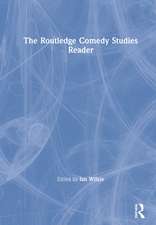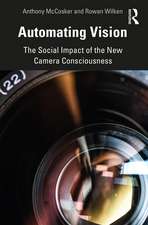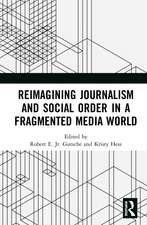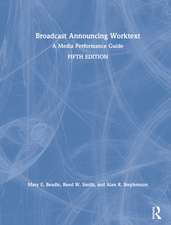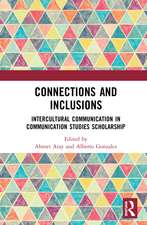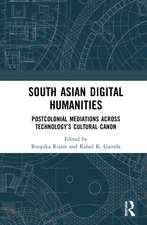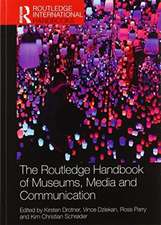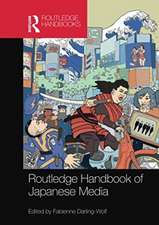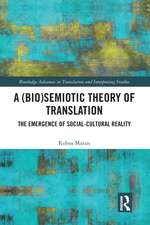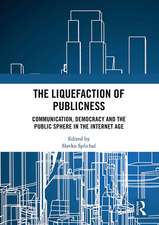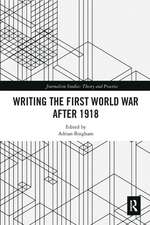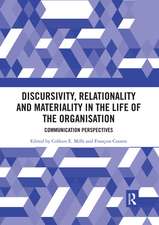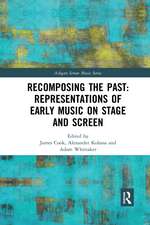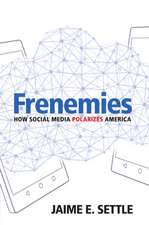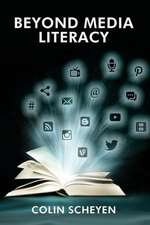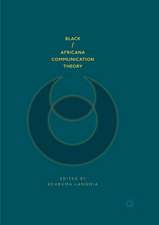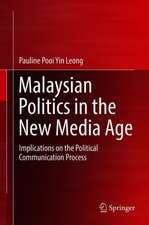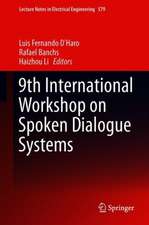Art History for Filmmakers: The Art of Visual Storytelling: Required Reading Range
Autor Dr Gillian McIveren Limba Engleză Paperback – 27 noi 2019
Din seria Required Reading Range
- 18%
 Preț: 232.80 lei
Preț: 232.80 lei - 28%
 Preț: 203.39 lei
Preț: 203.39 lei - 17%
 Preț: 278.47 lei
Preț: 278.47 lei -
 Preț: 329.39 lei
Preț: 329.39 lei - 17%
 Preț: 260.20 lei
Preț: 260.20 lei - 13%
 Preț: 315.47 lei
Preț: 315.47 lei - 37%
 Preț: 229.08 lei
Preț: 229.08 lei - 8%
 Preț: 319.44 lei
Preț: 319.44 lei - 10%
 Preț: 226.26 lei
Preț: 226.26 lei - 12%
 Preț: 276.17 lei
Preț: 276.17 lei - 23%
 Preț: 235.80 lei
Preț: 235.80 lei - 20%
 Preț: 248.77 lei
Preț: 248.77 lei - 21%
 Preț: 207.54 lei
Preț: 207.54 lei - 21%
 Preț: 228.71 lei
Preț: 228.71 lei -
 Preț: 192.59 lei
Preț: 192.59 lei - 18%
 Preț: 300.86 lei
Preț: 300.86 lei - 21%
 Preț: 192.91 lei
Preț: 192.91 lei - 37%
 Preț: 199.46 lei
Preț: 199.46 lei - 20%
 Preț: 281.87 lei
Preț: 281.87 lei -
 Preț: 239.14 lei
Preț: 239.14 lei - 12%
 Preț: 206.22 lei
Preț: 206.22 lei - 5%
 Preț: 258.90 lei
Preț: 258.90 lei - 11%
 Preț: 232.38 lei
Preț: 232.38 lei - 11%
 Preț: 275.11 lei
Preț: 275.11 lei - 12%
 Preț: 266.68 lei
Preț: 266.68 lei - 11%
 Preț: 282.17 lei
Preț: 282.17 lei - 12%
 Preț: 244.56 lei
Preț: 244.56 lei -
 Preț: 263.93 lei
Preț: 263.93 lei - 35%
 Preț: 201.01 lei
Preț: 201.01 lei -
 Preț: 277.47 lei
Preț: 277.47 lei -
 Preț: 206.98 lei
Preț: 206.98 lei - 20%
 Preț: 249.29 lei
Preț: 249.29 lei - 20%
 Preț: 282.62 lei
Preț: 282.62 lei - 19%
 Preț: 289.40 lei
Preț: 289.40 lei -
 Preț: 278.33 lei
Preț: 278.33 lei -
 Preț: 311.52 lei
Preț: 311.52 lei
Preț: 281.25 lei
Preț vechi: 353.64 lei
-20% Nou
Puncte Express: 422
Preț estimativ în valută:
53.82€ • 56.19$ • 44.54£
53.82€ • 56.19$ • 44.54£
Carte disponibilă
Livrare economică 14-28 martie
Preluare comenzi: 021 569.72.76
Specificații
ISBN-13: 9781501362309
ISBN-10: 1501362305
Pagini: 256
Ilustrații: 200 colour illus
Dimensiuni: 210 x 270 mm
Greutate: 0.89 kg
Editura: Bloomsbury Publishing
Colecția Bloomsbury Academic
Seria Required Reading Range
Locul publicării:London, United Kingdom
ISBN-10: 1501362305
Pagini: 256
Ilustrații: 200 colour illus
Dimensiuni: 210 x 270 mm
Greutate: 0.89 kg
Editura: Bloomsbury Publishing
Colecția Bloomsbury Academic
Seria Required Reading Range
Locul publicării:London, United Kingdom
Caracteristici
Beautifully illustrated with both film and art images; paintings are shown alongside film stills, enabling readers to identify visual links in terms of lighting, colour, composition and the mise-en-scene
Notă biografică
Gillian McIver studied History at the Universities of British Columbia and Toronto, and studied Film at the University of Westminster.She has curated exhibitions and ran an East London gallery. Her artist films have been screened widely, and she works as a producer and director. She has been a Visiting Lecturer at many institutions, and has taught at Roehampton University and SAE Institute London.
Cuprins
IntroductionWhat is art history and how does it relate to cinema history?; How is art history useful for filmmakers?; Painting as a record of what the past looked like in the imagination of artists; Painting and the use of visual language; A brief linear (traditional) history of art; Towards an "alternative" history of artChapter 1: Visual Culture and StorytellingNarrative and storytelling in art; Narrative in painting and cinema; Case study: William Hogarth's The Rake's Progress,and Darren Aronofsky's Requiem for a Dream; Exercise; Discussion questions Chapter 2: Creating the Visual - Perspective, Colour and LightingA brief history of perspective; Colour theory and colour psychology; How to use light; Case Study: Rembrandt, and Peter Greenaway's The Cook, the Thief, His Wife and Her Lover and Nightwatching; Exercise; Discussion questions Chapter 3: Realism in Visual ArtRealism; What is representation?; Art after photography: Modern conceptions of realism in art; Case study: Johannes Vermeer, and Peter Webber's The Girl with the Pearl Earring (DoP Eduardo Serra); Exercise; Discussion questions Chapter 4: Beyond RealismFantasy worlds in cinema and art; Oneiric: The world of dreams; Surrealism; Going beyond the real; Case study: Jack Cardiff (DoP) and A Matter of Life and Death (dir. Michael Powell and Emeric Pressburger); Exercise; Discussion questions Chapter 5: Sex and ViolenceSex; Violence; Case study: Caravaggio, and Martin Scorsese's Taxi Driver ; Exercise; Discussion questions Chapter 6: Horror From dream to nightmare; Monsters; Case study: Francisco Goya, and Guillermo del Toro's Pan's Labyrinth and Pacific Rim; Exercise; Discussion questions Chapter 7: LandscapeWhat is landscape painting?; The Western; Case study: Albert Beirstadt, Andrew Wyeth, and Ed Harris's Appaloosa. Exercise; Discussion questions Chapter 8: History and HeroismHistory painting: Victory, virtue, and the hero; Case study: Quentin Tarantino's Diango Unchained and Gainsborough's Blue Boy; Exercise; Discussion questions Chapter 9: Modern MovementsExpressionism; Minimalism; Beyond Western culture; Case study: Katsushika Hokusai and Disney; Cinema as contemporary art; Exercise; Discussion questionsChapter 10: Conclusion - Using art history in film-makingFilm-making roles and art; Case study: Terrence Malick, Nestor Almendros and Andrew Wyeth (Days of Heaven); Case study: Conrad Hall, Sam Mendes and Edward Hopper (Road to Perdition); Case study: Wally Pfister, Christopher Nolan and MC Escher (Inception)
Recenzii
Excellent integration of art and film. Particularly useful in regard to cinematography and mise en scene. Ideas are well-expressed and illustrated. This text will cause filmmakers to look anew at painting.
This is an outstanding book for filmmakers, opening up art history and providing a visual vocabulary beyond the technically cinematic that is sure to enhance student and professional work. In taking a broad survey of art movements and linking to examples of contemporary and classic cinema, this is an approachable, essential text for film production students as well as writers and directors seeking to augment their visual knowledge.
This is a nicely presented and engaging text which relates film to fine art practice in a novel and interesting way. It will be useful for students extending their practice in film making and should inspire them to consider the origins and impact of decisions in composition and lighting.
This is an outstanding book for filmmakers, opening up art history and providing a visual vocabulary beyond the technically cinematic that is sure to enhance student and professional work. In taking a broad survey of art movements and linking to examples of contemporary and classic cinema, this is an approachable, essential text for film production students as well as writers and directors seeking to augment their visual knowledge.
This is a nicely presented and engaging text which relates film to fine art practice in a novel and interesting way. It will be useful for students extending their practice in film making and should inspire them to consider the origins and impact of decisions in composition and lighting.
